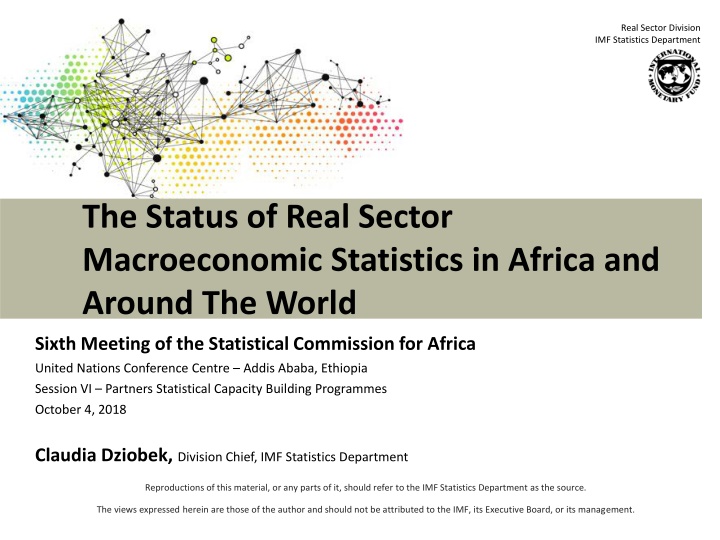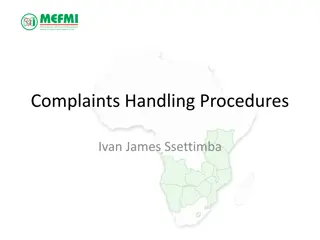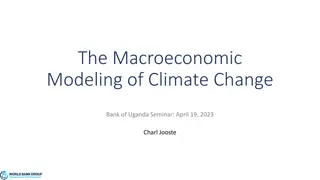
IMF Statistics Department: Real Sector Division Insights
Discover the key roles of the IMF Statistics Department's Real Sector Division in providing economic surveillance, lending, and capacity development, focusing on GDP and prices for supporting Africa's economic policy objectives and SDGs. Explore how reliable statistics impact various SDG goals and indicators.
Download Presentation

Please find below an Image/Link to download the presentation.
The content on the website is provided AS IS for your information and personal use only. It may not be sold, licensed, or shared on other websites without obtaining consent from the author. If you encounter any issues during the download, it is possible that the publisher has removed the file from their server.
You are allowed to download the files provided on this website for personal or commercial use, subject to the condition that they are used lawfully. All files are the property of their respective owners.
The content on the website is provided AS IS for your information and personal use only. It may not be sold, licensed, or shared on other websites without obtaining consent from the author.
E N D
Presentation Transcript
Real Sector Division IMF Statistics Department The Status of Real Sector Macroeconomic Statistics in Africa and Around The World Sixth Meeting of the Statistical Commission for Africa United Nations Conference Centre Addis Ababa, Ethiopia Session VI Partners Statistical Capacity Building Programmes October 4, 2018 Claudia Dziobek, Division Chief, IMF Statistics Department Reproductions of this material, or any parts of it, should refer to the IMF Statistics Department as the source. The views expressed herein are those of the author and should not be attributed to the IMF, its Executive Board, or its management.
Real Sector Division IMF Statistics Department The IMF s Key Roles Economic Surveillance Provide advice to members on adopting policies that can help them achieve macroeconomic stability, thereby accelerating economic growth and alleviating poverty. Lending Make financing temporarily available to member countries to help them address balance of payments problems, which include circumstances in which they find themselves short of foreign exchange because their external payments exceed their foreign exchange earnings. Capacity Development Offer technical assistance and training to countries, at their request, to help them build and strengthen the expertise and institutions they need to implement sound economic policies, including price statistics. (IMF 2017 Annual Report) http://www.imf.org/external/pubs/ft/ar/2017/eng/pdfs/IMF-AR17-English.pdf 2
Real Sector Division IMF Statistics Department Capacity Development GDP and Prices Reliable and timely GDP and price statistics are essential to support Africa s economic policy objectives and GDP and other national accounts measures (e.g. household expenditure) are inputs for many policy indicators GDP and CPI serve as references to adjust wages, pensions, social benefits, as indicators of debt sustainability Producer price index and CPI support estimates of real GDP Timeliness is key to support forecasting and data analysis. 3
Real Sector Division IMF Statistics Department GDP and Prices are central to the SDGs and Indicators Government Finance Statistics Balance of Payments Financial Access Survey National Accounts and Prices More than one-third of SDG Indicators include economic variables Impacts SDG Goals: 1, 7, 10, 11, 14, 16, and 17 Linked directly to SDG Goals 7 and 17 Impacts SDG Goals: 2, 3, 8, 9, 10, 15, 16, and 17 Linked directly to an indicator under SDG Goal 8 Impacts SDG Goals: 1, 2, 7, 8, 9, 10, 11, 12, and 14 SDG Indicators 232 4
Real Sector Division IMF Statistics Department Key Criteria for GDP Age of benchmark year The availability of quarterly GDP Timeliness of dissemination Independence of production and expenditure GDP The SNA vintage applied This presentation is based on a study of 192 countries, published as an IMF Working Paper. (Berry, Stanger, Iommi, Venter, GDP: How Useful are the Data for Policy?). The slides labeled Africa refer to UNECA countries. 5
Real Sector Division IMF Statistics Department GDP - Age of Benchmark Year SNA recommends updated GDP benchmarks (usually every 5-10 years) AFRICA 189 economies Older than 15 years 15% Older than 15 years 16% 1-10 years 33% 1-10 years 50% 11 -15 years 52% 11 -15 years 34% 6
Real Sector Division IMF Statistics Department Availability of Annual (A) and Quarterly (Q) GDP A GDP : 100% A GDP : 96% 100% 90% 80% Q GDP: 72% 70% 60% 50% Q GDP: 37% 40% 30% 20% 10% 0% 192 economies Africa 7
Real Sector Division IMF Statistics Department GDP Timeliness of Dissemination Annual GDP AFRICA 189 economies Later than 15 Months 17% Later than 15 Months 23% 10 - 15 Months 11% 9 months or less 56% 9 months or less 72% 10 - 15 Months 21% 8
Real Sector Division IMF Statistics Department GDP Timeliness of Dissemination Quarterly GDP AFRICA 133 economies 4 - 6 Months 3% Later than 6 Months 19% 4 - 6 Months 17% Later than 6 Months 83% 3 months or less 78% 9
Real Sector Division IMF Statistics Department GDP by Region and Approach 100% 96% 96% 100% 91% 90% 80% 66% 70% 60% 50% 50% 40% 30% 20% 10% 0% 144 economies Africa Expenditure App Production App Income App 10
Real Sector Division IMF Statistics Department Are Production and Expenditure GDP Derived Independently? AFRICA 167 economies YES 14% NO 51% YES 49% NO 86% 11
Real Sector Division IMF Statistics Department Vintage of SNA AFRICA 189 economies 2008 SNA / ESA 1995 42% 2008 SNA / ESA 1995 58% 2008 SNA / ESA 1995 51% 2008 SNA / ESA 2010 49% 12
Real Sector Division IMF Statistics Department GDP Compilation in Africa Key Points Keep the base year up to date Develop quarterly GDP Publish data in a timely manner In 50-60* percent of UNECA countries, these are the key deficiencies. For countries that are fast growing, experience large demographic or technological change, these three points are very important to maintain relevance of the data. * Consult IMF Working Paper: GDP: How Useful are the Data for Policy?, Washington DC (2018) for country-specific details and whether this applies to your country. 13
Real Sector Division IMF Statistics Department Price Statistics to Support Policy Timeliness and frequency of publication Classification system adopted Geographic (CPI) and industrial (PPI) coverage Currentness of weights reference period This part of the presentation is based on the forthcoming IMF Working Paper: Price Statistics in 196 Economies: The Relevance for Policy Analysis. 14
Real Sector Division IMF Statistics Department CPI: Timeliness and Frequency AFRICA 196 economies Quarterly, delay > 1 month 2% Quarterly, delay > 1 month 3% Quarterly, within 1 month 0% Quarterly, within 1 month 4% Monthly, within 1 month 86% Monthly, delay > 1 month 2% Monthly, within 1 month 96% Monthly, delay > 1 month 7% 15
Real Sector Division IMF Statistics Department CPI: COICOP Classification AFRICA 196 economies Other 24% Other 32% COICOP 76% COICOP 68% 16
Real Sector Division IMF Statistics Department CPI: Geographic Coverage AFRICA 196 economies National, 30 (57%) National, 126 (64%) Urban, 6 (11%) Urban, 39 (20%) Capital city, 17 (32%) Capital city, 31 (16%) 17
Real Sector Division IMF Statistics Department CPI: Age of Weights Reference Period target AFRICA 196 economies Older than 15 years 4% Older than 15 years 7% Within 5 years 23% 11-15 Years 16% 11-15 Years 19% Less than 5 years 38% 5 - 10 Years 51% 5 - 10 Years 42% 18
Real Sector Division IMF Statistics Department PPI: Timeliness and Frequency target AFRICA 126 economies Quarterly, delay > 1 month 14% Less frequently 6% Quarterly, delay > 1 month 35% Quarterly, within 1 month 3% Monthly, within 1 month 53% Monthly, within 1 month 68% Quarterly, within 1 month 6% Monthly, within 1 quarter 9% Monthly, within 1 quarter 6% 19
Real Sector Division IMF Statistics Department PPI: Classification ISIC target AFRICA 126 economies Other 19% Other 25% ISIC Rev.3 19% ISIC Rev.4 62% ISIC Rev.4 54% ISIC 8% ISIC Rev.3 13% 20
Real Sector Division IMF Statistics Department PPI: Industrial Coverage MMU: mining, manufacturing and utilities AFRICA 126 economies >MMU 9% <MMU 27% >MMU 33% <MMU 46% MMU 45% MMU 40% 21
Real Sector Division IMF Statistics Department PPI: Age of PPI Weight Reference Period target AFRICA 126 economies Older than 15 years 4% Older than 15 years: 9% 11-15 Years 9% 11-15 Years 14% Within 5 years 27% Within 5 years 36% 5 - 10 Years 55% 5 - 10 Years 46% 22
Real Sector Division IMF Statistics Department Key Points for Price Statistics in Africa CPI Compiled almost universally, monthly, timely, fairly well aligned with international standards but weights are often out of date. PPI (Producer Price Index) Not compiled in over half of UNECA countries. PPI is needed for real GDP estimates and key to show the real picture of GDP growth, diversification, the growing role of services, etc. Those who compile a PPI should maintain updatedweights to reflect the changing economy. 23
Real Sector Division IMF Statistics Department General Conclusions Africa compares favorably with the rest of the world (as a whole) in most areas. Quarterly GDP, updated weights, updated base years (GDP), and timely dissemination are the key areas where improvements are needed. This requires investments in the source data (including administrative data, surveys, etc.). The availability of good quality GDP and prices indicators are key factors for the enhancement of policies targeting economic diversification and industrialization. 24
Real Sector Division IMF Statistics Department Thank you






















